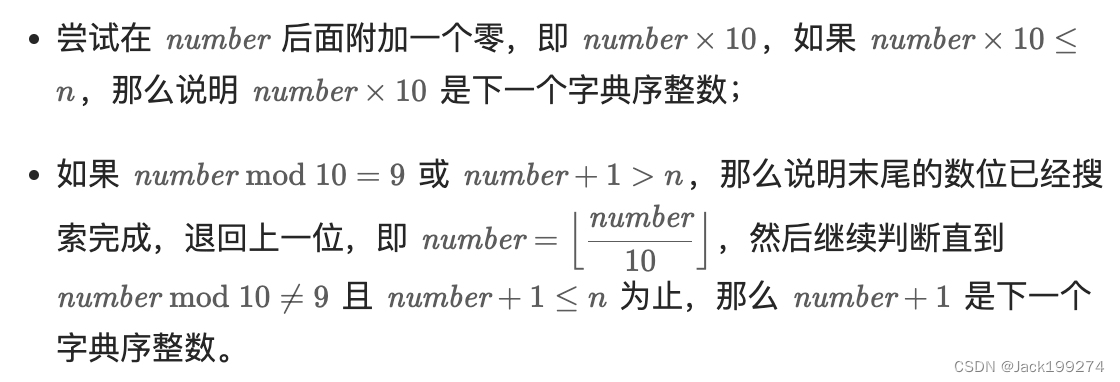TikTok真题第5天 | 386. 字典序排数、785.判断二分图、886.可能的二分法
386. 字典序排数
题目链接:386.exicographical-numbers
解法:
解法1:DFS,也就是回溯。第一层从1开始,遍历到9,而后面层的循环,也就是递归,从0遍历到9。如果当前节点的数大于n了,那就回溯。但是DFS递归的空间复杂度大于O(1)。
参考【宫水三叶】的题解:DFS(回溯)

解法2:迭代法。对于一个整数?number=1,按照一定的规则去找他的下一个字典序整数,并不断加入结果集中。由于只是不断更新number,所以额外空间为O(1)。更新规则如下:

迭代看了这个规则也不太好理解,把代码模拟运行一下就理解了。
比如第二个条件,n=234时,如果number=199了,那么199 / 10 = 19, 19 / 10 = 1, 1+1=2,也是后面的字典序整数就是:2, 20, 200,..., 21,...。
如果number=234了,那么234 / 10 = 23, 23+1 = 24,那么后面的字典序整数就是:24, 25, ..., 29
参考题解:leetcode官网迭代法
边界条件:无
时间复杂度:O(n)
空间复杂度:回溯O(n),迭代O(1)
// 回溯
class Solution {
vector<int> result;
public:
vector<int> lexicalOrder(int n) {
// 第一层遍历从1到9,因为0不能作为开头
for (int i=1; i<=9; i++) {
traversal(i, n);
}
return result;
}
private:
void traversal(int cur, int limit) {
if (cur > limit) return;
result.push_back(cur);
for (int i=0; i<=9; i++) {
cur = cur * 10 + i;
// 横向剪枝
if (cur > limit) break;
traversal(cur, limit);
// 为了清晰地展示回溯撤销的操作,没有合并
cur = (cur - i) / 10;
}
}
};// 迭代法
class Solution {
public:
vector<int> lexicalOrder(int n) {
vector<int> result(n);
int cur = 1;
for (int i=0; i<n; i++) {
result[i] = cur;
if (cur * 10 <= n) {
cur *= 10;
} else {
// 比如n=234,cur=199,那么需要回撤到1,再从2开始
while (cur % 10 == 9 || cur + 1 > n) {
cur /= 10;
}
cur++;
}
}
return result;
}
};785.判断二分图
解法:
这个题有两种解法:染色法和并查集。并查集本身就是一个很大的内容,所以这里只用染色法。
任选一个节点开始,给它染成红色。随后我们对整个图进行遍历,将该节点直接相连的所有节点染成绿色,表示这些节点不能与起始节点属于同一个集合。我们再将这些绿色节点直接相连的所有节点染成红色,以此类推,直到无向图中的每个节点均被染色。
而如果在过程中,节点直接相邻的节点存在颜色和该节点相同(之前已经被染过),那么染色失败。
解题思路参考:leetcode官网染色法
官网的思路很清晰,但代码实现不简洁,具体代码实现还参考了:知乎染色法
边界条件:
时间复杂度:O(n+m),其中 n?和 m分别是无向图中的点数和边数。
空间复杂度:O(n),存储节点颜色的数组需要 O(n)?的空间,并且在深度优先搜索的过程中,栈的深度最大为 n,需要 O(n)的空间。
// DFS染色法
class Solution {
static constexpr int UNCOLORED = 0;
static constexpr int RED = 1;
static constexpr int GREEN = 2;
vector<int> colors;
public:
bool isBipartite(vector<vector<int>>& graph) {
int n = graph.size();
colors.assign(n, UNCOLORED);
for (int i=0; i<n; i++) {
if (colors[i] == UNCOLORED) {
if (!dfs(i, RED, graph)) return false;
}
}
return true;
}
bool dfs(int cur, int color, vector<vector<int>>& graph) {
// 参数color是cur应该染的颜色
// 如果cur已经被染色,但已经染的颜色不是color,表明染色失败
if (colors[cur] != UNCOLORED) {
return colors[cur] == color;
}
colors[cur] = color;
// 这是邻接点应该染的颜色,和cur的不同
int colorNext = color == RED? GREEN: RED;
for (int next: graph[cur]) {
// 遍历所有邻接点,如果该染的颜色和已经染的不同,则失败
if (!dfs(next, colorNext, graph)) return false;
}
return true;
}
};886.可能的二分法
解法:
这个题是上一个题的加强版,也是用染色法或者并查集解决,所以在做此题之前,先把上一个题干掉了。这个tag题的出题频率更高。
这个题其实就比785改动了两个地方:(1)需要自己构建邻接表;(2)点的起始值是1而不是0。
也就是说,只要我们构建好邻接表,然后把起始值从1改为0,那就可以完全复用785的代码了。
参考题解:LeetCode 886 - 可能的二分法 (Python3|Go)[递归/DFS] Possible Bipartition - 知乎
边界条件:无
时间复杂度:O(n+m)
空间复杂度:O(n)
//染色法
class Solution {
static constexpr int UNCOLORED = 0;
static constexpr int RED = 1;
static constexpr int GREEN = 2;
vector<int> colors;
public:
bool possibleBipartition(int n, vector<vector<int>>& dislikes) {
// 构建邻接表
vector<vector<int>> graph(n);
for (const auto& dis: dislikes) {
int a = dis[0] - 1;
int b = dis[1] - 1;
graph[a].push_back(b);
graph[b].push_back(a);
}
return isBipartite(graph);
}
bool isBipartite(vector<vector<int>>& graph) {
int n = graph.size();
colors.assign(n, UNCOLORED);
for (int i=0; i<n; i++) {
if (colors[i] == UNCOLORED) {
if (!dfs(i, RED, graph)) return false;
}
}
return true;
}
bool dfs(int cur, int color, vector<vector<int>>& graph) {
// 参数color是cur应该染的颜色
// 如果cur已经被染色,但已经染的颜色不是color,表明染色失败
if (colors[cur] != UNCOLORED) {
return colors[cur] == color;
}
colors[cur] = color;
// 这是邻接点应该染的颜色,和cur的不同
int colorNext = color == RED? GREEN: RED;
for (int next: graph[cur]) {
// 遍历所有邻接点,如果该染的颜色和已经染的不同,则失败
if (!dfs(next, colorNext, graph)) return false;
}
return true;
}
};本文来自互联网用户投稿,该文观点仅代表作者本人,不代表本站立场。本站仅提供信息存储空间服务,不拥有所有权,不承担相关法律责任。 如若内容造成侵权/违法违规/事实不符,请联系我的编程经验分享网邮箱:chenni525@qq.com进行投诉反馈,一经查实,立即删除!
- Python教程
- 深入理解 MySQL 中的 HAVING 关键字和聚合函数
- Qt之QChar编码(1)
- MyBatis入门基础篇
- 用Python脚本实现FFmpeg批量转换
- Excel到EDI报文转换代码详解
- 前端基础知识整理汇总(下)
- 获取网页信息
- Hashicorp Consul Service API远程命令执行漏洞
- casadi安装全流程
- 100天精通鸿蒙从入门到跳槽——第6天:TypeScript 知识储备:类
- 抖音开始内测“AI 搜”功能;提示工程课程
- git变更关联的远程仓库
- 第一篇【传奇开心果】Vant 开发移动应用:从helloworld开始
- 从入门到精通,30天带你学会C++【第九天:排序合集】